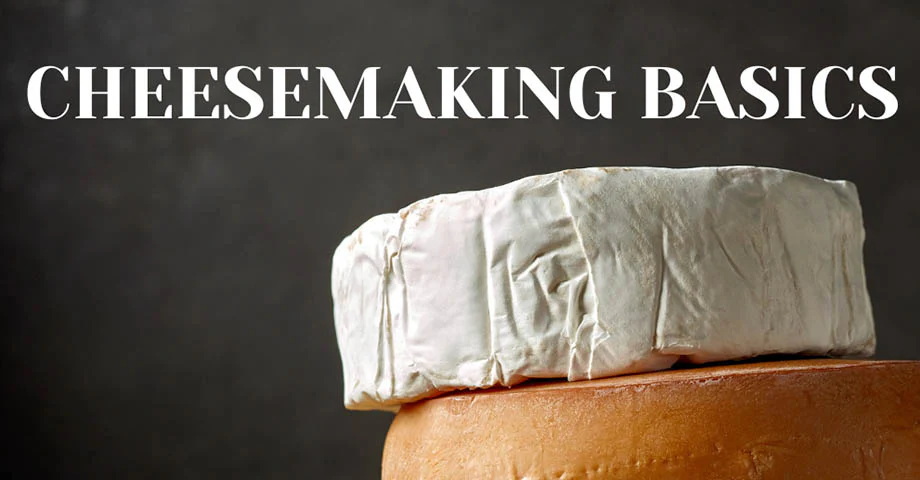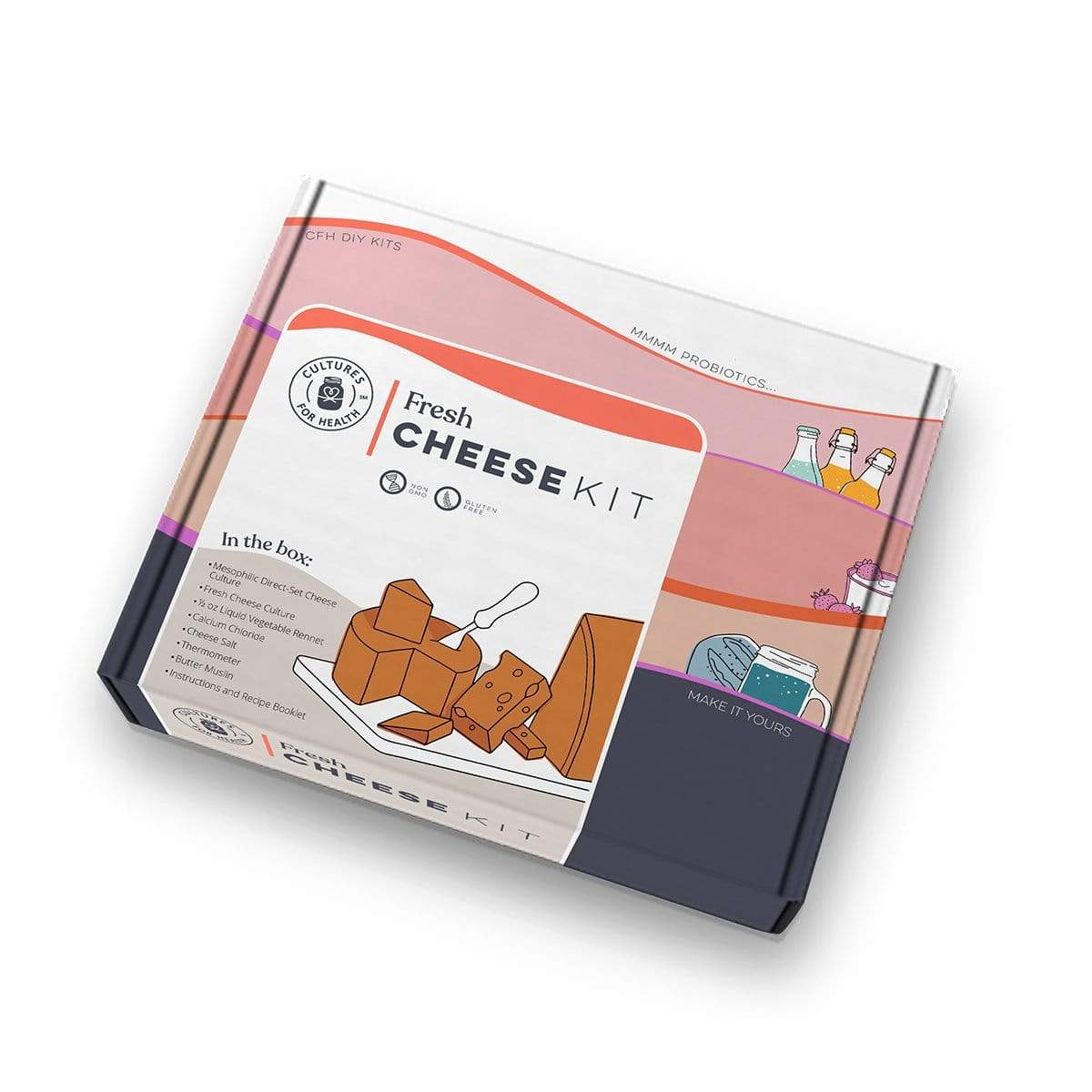
Cheese is made in a wide variety of styles, tastes, aromas, and consistencies; from soft to hard, sharp to mild, and wet to dry. Traditionally, cheese is made by culturing milk either by encouraging natural enzymes and bacterial action (in raw milk), or by using a starter culture. While the exact steps and ingredients may vary between recipes, the fundamentals stay the same.
SANITIZING YOUR WORK AREA
Cleanliness before, during, and after making cheese is very important. Before you begin your first cheese project, review our article on Sanitization During Cheesemaking for tips on keeping the cheese work area and utensils clean to avoid contamination. 
BASIC INGREDIENTS FOR MAKING CHEESE
Fresh Cheese Making Kit
While there is some variation and individual choice within each category, there are four basic ingredients usually used to make any cheese: milk, starter culture, coagulant, and salt.
Milk for Cheesemaking
The main and most important ingredient in any cheese is milk, of course. Cheese can be made using almost any type of animal milk, though cow, goat, and sheep milk are most commonly used. Raw or pasteurized milk is fine for cheesemaking. It is best to avoid ultra-pasteurized or ultra-high temperature pasteurized milk since it is highly processed and will not produce a satisfactory curd. The following articles are helpful for learning more about choosing milk for cheesemaking:
Cheese Starter Cultures
There are many, many different kinds of cheese culture available. Cheese starter cultures are usually sold in powdered form and consist of a specifically selected group of bacteria that cause acidification, making your milk the perfect environment for good bacteria growth and flavor development. The cheese starter culture used determines the taste, texture, and aroma of the final cheese.
For a review of all cheese starter cultures available at Cultures for Health, consult our Guide to Cheese Cultures, or purchase cheese cultures.
Coagulants Used in Cheesemaking
Coagulants are added after the starter culture and are used to solidify milk protein into cheese curds. The most common coagulant is animal rennet, but vegetable rennet is available as well, in both liquid and tablet form.
Learn more about Rennet and Other Coagulants from our staff Cheese Expert or browse our available rennet products.
Salt for Cheesemaking
Salt is a natural preservative and a very important element in good cheesemaking, not only for flavor. To learn more about why cheese is salted and what type of salt is best for cheesemaking, consult our article, Salt in Cheesemaking.
CHEESEMAKING SUPPLIES
Most soft cheeses can be made using common kitchen items. Check our Basic Supply List for Beginning Cheesemakers to see if you already own everything on the list.
When ready to advance to hard cheeses and more difficult cheesemaking tasks, add to your supplies from our list of Advanced Cheesemaking Equipment or browse our wide selection of home cheesemaking supplies.
If you are a beginning cheesemaker, start with small batches and basic recipes, and learn about ingredients and techniques from our staff. Our Introduction to Soft Cheeses is a great place to begin learning about soft cheesemaking.
In addition to the ingredients and basic concepts of cheesemaking covered in Cheesemaking Basics, Part I, there are some general techniques used in making cheese at home, from start to storage.
THE BASIC CHEESEMAKING PROCESS
The basic cheesemaking process usually involves four fundamental steps.
- Warming the Milk
- Adding Starter Culture and Rennet
- Draining the Curd
- Salting and Storing the Cheese
These steps apply to nearly any cheese recipe and are discussed in more detail in our Introduction to Soft Cheeses. However, when you venture into crafting hard cheeses, there are more elements involved in the cheesemaking process...
ADVANCED TECHNIQUES FOR MAKING HARD CHEESE
Pressing Hard Cheeses
To make hard cheese, once the cheese curds have drained, it is time to put them into the cheese press. If the recipe does not specify pressing time or pressure, apply enough pressure to compress the curds without causing them to squeeze out of the mold. When the whey stops coming out of the cheese, release the pressure, flip the cheese, restore adequate pressure, and keep an eye on it. Learn more about Pressing Hard Cheeses.
General Rule for Pressing Hard Cheeses: The fallback rule for pressing a hard cheese is 1 hour at about 5 pounds of pressure. Flip and press overnight at 20 pounds. Flip and press again at 20 pounds for 8-10 hours more.
METHODS FOR PREPARING HARD CHEESE FOR AGING
1. Brining or Salt Rubs
Some types of cheese call for soaking in brine or rubbing with salt. For details on how to prepare brine, consult our article, Brining Hard Cheeses.
Below are examples of brined cheeses:
Dry salt rubs can be done very simply, by just sprinkling the needed amount of salt on the cheese wheel, and rubbing it gently over the entire surface of the cheese.
Leicester is an example of a cheese requiring a dry salt rub.
2. Bandaging or Wrapping Hard Cheeses
Bandaging is done to assist proper rind formation and development of full flavor profiles and textures in hard cheese. Consult our article for complete instructions on Bandaging Hard Cheeses.
AGING HARD CHEESES
Aging will be perhaps the trickiest and most challenging step in producing homemade cheese, but it is also one of the most important. Specific directions for aging different types of cheese can vary. Humidity, darkness, heat, cold, and air quality all affect your cheese as it ripens. For details on the proper conditions for aging cheese, consult these helpful articles:
STORING HARD CHEESES
Once cheese is aged and ready to consume, it will last longest if kept wrapped and stored properly. Check our information in this article on Wrapping and Storing Different Types of Cheeses to find the method that is best for keeping your cheese as long as possible.
GET STARTED MAKING HARD CHEESES
Pick a recipe from our list of Hard Cheese Recipes, grab a cheese starter culture and supplies, and start your next cheesemaking project!
Still have questions? Contact us today, we’re happy to help!


















